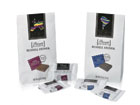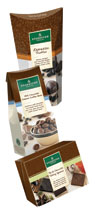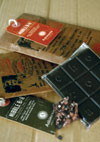
Middle-end chocolate manufacturers are moving into the luxury chocolate niche. How is packaging being designed to reflect brand quality?
Oh, how sweet it is. Even in turbulent economic times, the high-end chocolate market is a major profitable segment of the $17-billion-a-year U.S. candy industry. And it’s expected to almost double over the next five years, according to a Mintel report.
While middle-end chocolate sells more in volume, the profitability of the chocolate industry’s high-end segment has carried the industry. Because of this, many middle-market chocolate manufacturers are moving into the high-end market with premium extensions of already established brands. How does this challenge brand image and packaging?

Middle-market manufacturer Russell Stover's premium Private Reserve Origin Select chocolate squares are packaged similarly to other high-end chocolates: individually-wrapped and in stand-up roll-top bags.
Movin' on up
Moving into the high-end market and creating a new image and following can be difficult. Consumers usually purchase products that they’re already familiar with. A brand can take a market by storm upon its initial launch, but often requires constant promotion and new product additions to keep it fresh both on the shelf and in the mind of the consumer.Companies such as Hershey or Mars may have a tougher time, given how long they’ve been around, and how synonymous they are with the middle-end chocolate market. Even a well-known brand like Dove took years to develop momentum and target the right demographic for its line of more indulgent chocolate to hit its mark.
However, with the recent releases of products such as Hershey’s Bliss and M&M’s Premiums, middle-end companies have found ways to maintain difference.
“When the M&M’s Premiums were launched, it marked the first product that was M&M’s-related that is truly different: different in packaging, different in formulation, different in flavor and trying to set itself apart,” says Brian Morgan, senior research analyst at Euromonitor. (Read more about M&M's Premiums' new packaging.)
However, a company with a foot planted firmly in a certain food or beverage market may have an easier time moving into the high-end chocolate arena. Take Starbucks, for example. According to Morgan, as a major player in the coffee arena, Starbucks already had an advantage when it introduced its premium chocolate, and shows strong staying power by introducing products such as liqueurs and ice cream to solidify the brand’s image in consumers’ minds and make the product appear even more “premium.”

Starbucks mastered the link between quality coffee and chocolate with packs that stand tall and with individually-wrapped tasting squares that feature color schemes found in their cafés.
Shelf identity
For the consumer to identify a product as premium, it needs to portray that image on the shelf.“Packaging is important to create this image of something that is a little more indulgent, something set apart from other brands that it’s next to on the shelf. That has been done successfully in the last two or three years,” says Morgan.
Differences in the color scheme of the branding and logos make a product stand out on the shelf, and while the tray-in-box has been used in the past to convey a premium image, packaging such as the individually-wrapped chocolate square and the roll-top stand-up bag have become iconic for premium chocolate. These packages also offer stronger protection than a simple wrapper or plastic bag.
“Pretty much every high-end premium line has the individually-wrapped pieces in the roll-top bags, as opposed to the flat chocolate bar, which is still out there and still a more popular format, but definitely seen as something more down-market in terms of quality,” says Morgan.
Lindt and Ghirardelli are instantly recognizable on store shelves by their individually wrapped chocolate squares in roll-top bags, and other brands have followed suit. Russell Stover, a middle-end chocolate manufacturer, released its Private Reserve and Origin Select premium chocolates, packaged the same way.
Russell Stover chose rotogravure printing for the individual chocolate wraps to ensure premium presentation of each line’s graphics. Sonoco, the laminated film supplier, replicated the bag’s graphics on the wraps to ensure a consistent brand experience once consumers opened the bag.
Other brands have innovated packaging to stand out on shelves next to these roll-top bags. Starbucks has released its line of artisan chocolate in paperboard boxes that stand as tall as a roll-top bag, but are uniquely shaped, differentiating them from other high-end chocolate brands. M&M’s Premiums also come in a tall paperboard box with curved sides, increasing the product’s appeal.
“A lot of stores have to create entire sections of the aisle that are just for premium-end chocolates that use that packaging style, and can’t be placed on the shelf next to a traditional candy bar flat package,” says Morgan. “I think the Starbucks [chocolate] launch was a concerted effort to create this package style and also dictate how it would look on the shelf.”

Askinosie Chocolate chose Innovia Films' NatureFlex biodegradable film to fit the "environmentally-friendly" image of its brand.
Sustainability sweetened
Of course, more elaborate packaging usually uses more materials. Adding individualized primary packaging, more sophisticated secondary packaging and foil packaging shows that material reduction is less of a primary concern to most major chocolate manufacturers. According to Morgan, it looks like it will remain that way for some time.“If there are groups of consumers that are concerned about [the environment], the push has been more toward the chocolate itself,” says Morgan. “Fair trade is doing very well, and organic is still an area that is developing. Smaller brands that are exclusively fair trade will also have sustainable packaging, and so on, but that’s a secondary concern.”
That’s not to say that there aren’t some high-end manufacturers looking for sustainable options; sustainable packaging can fit an organic product’s brand image and ethos. Along with paying farmers above fair trade prices and profit sharing with them, Missouri-based brand Askinosie Chocolate recently chose Innovia Films’ Natureflex, a non-genetically modified, wood-based product that is home compostable, to package its chocolate bars.
“Our company has implemented vertical sustainability throughout our business practices with everything from the way we source our cocoa beans and our profit sharing program with our farmers, to the products we produce and sell,” says Shawn Askinosie, founder of Askinosie Chocolate. “Our use of NatureFlex is just another important example of our concern for the environment.”
Superfood Snacks also used NatureFlex for its Chocolate Goji Treats stand-up bag. The bag is made from metallized NatureFlex laminated to high-gloss transparent NatureFlex film.
“Superfood Snacks felt that this special organic raw product needed packaging that was in alignment with the integrity of the company’s visions,” says Adam Collins, founder of Superfood Snacks.
Marks & Spencer recently won a DuPont award for its Swiss Chocolate Assortment’s biodegradable packaging inserts made from Plantic, a plant-based home compostable material from Plantic Technologies, which allows consumers to choose the most appropriate end-of-life disposal based on local infrastructure. The outer box, which is recyclable, also has disposal information.
Less product, smaller packaging
But even with the bevy of packaging options available, as the economy tightens consumers’ budgets and commodities prices rise, producers have to make cuts and raise prices. On the ingredients side, some chocolate manufacturers are substituting cocoa butter with vegetable oil, which is less expensive.According to a Todayshow.com report, manufacturers can change the formula if they label their product as “chocolate candy,” “made with chocolate” or “chocolatey.” Hershey is doing this with several of its products. However, in terms of high-end chocolate, since consumers already like the way their favorites taste, product amount will be reduced before formulas are altered. This will reduce packaging size.
This trend has already been seen in other sweet areas of the food industry. A couple examples include Nestlé’s Dreyer’s and Edy’s ice creams, which were among several major ice cream manufacturers to have shrunk standard sizes from 1.75 to 1.5 quarts, and Wrigley's chewing gum Slim Pack, a slimmer package offering 15 sticks instead of 17.
Still, chocolate isn’t a big ticket luxury item like a plasma television or car, so even when prices rise, consumers can afford paying a little extra for the already affordable indulgence.
“Consumers see spending a little extra money on a great-tasting piece of chocolate as a relatively inexpensive way to treat oneself on a regular basis,” says Danielle Jin, director of marketing at Ghirardelli. F&BP
FOR MORE INFORMATION
Innovia Films Inc.877-822-3456
Plantic Technologies
61-3-9353-7900 (Australia)
Sonoco
800-576-6626
